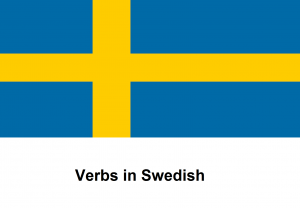Language/Swedish/Vocabulary/Verbs-in-Swedish
As you may know, verbs are one of the most important parts of a sentence. They tell us what someone or something is doing or what is happening. Swedish is a rich and complex language, and it has many verbs that you'll need to learn if you want to speak it fluently.
Here are some of the most common Swedish verbs that you should definitely add to your vocabulary:
Don't miss the chance to check out these pages as you wrap up this lesson: Asking Directions & How to express ownership.
Att vara (to be)[edit | edit source]
This is probably the most important verb in any language, and Swedish is no exception. Knowing how to conjugate "att vara" is essential if you want to communicate effectively in Swedish. Some examples of how it is used include:
- Jag är trött. (I am tired.)
- Hon är min vän. (She is my friend.)
- Vi är på festen. (We are at the party.)
Att ha (to have)[edit | edit source]
Another important verb is "att ha," which means "to have." Here are some examples of how it is used:
- Jag har en hund. (I have a dog.)
- De har mycket pengar. (They have a lot of money.)
- Hon har en examen i psykologi. (She has a degree in psychology.)
Att göra (to do/make)[edit | edit source]
"Att göra" is a versatile verb that can mean either "to do" or "to make." Here are some examples:
- Vad gör du? (What are you doing?)
- Jag gör middag. (I'm making dinner.)
- Han gjorde ett stort misstag. (He made a big mistake.)
Att säga (to say)[edit | edit source]
If you want to express something with words, you'll need to use "att säga." Here are some examples:
- Vad sa du? (What did you say?)
- Hon sa att hon skulle komma. (She said she would come.)
- De sa ingenting. (They didn't say anything.)
Att se (to see)[edit | edit source]
If you want to talk about visual perception, you'll need to use "att se." Here are some examples:
- Jag ser en fågel. (I see a bird.)
- Hon ser glad ut. (She looks happy.)
- Vi såg en film igår. (We saw a movie yesterday.)
Att vilja (to want)[edit | edit source]
If you want to express a desire, you'll need to use "att vilja." Here are some examples:
- Jag vill ha glass. (I want ice cream.)
- Hon vill inte gå. (She doesn't want to go.)
- Vi vill resa till Spanien. (We want to travel to Spain.)
Learning these common Swedish verbs will help you understand and communicate better in Swedish. But don't stop here! Keep learning more verbs and practicing your language skills. Lycka till! (Good luck!)
Other Useful Verbs in Swedish[edit | edit source]
| ENGLISH | SWEDISH |
|---|---|
| to drink | att dricka |
| to eat | att äta |
| to bite | att bita |
| to vomit | att spy |
| to laugh | att skratta |
| to see | att se |
| to hear | att höra |
| to know something | att veta något |
| to know someone | att känna någon |
| to think | att tänka |
| to smell | att lukta |
| to fear | att frukta |
| to sleep | att sova |
| to live | att leva |
| to die | att dö |
| to fight | att slåss |
| to touch | att röra |
| to cut | att skära |
| to dig | att gräva |
| to swim | att simma |
| to fly | att flyga |
| to walk | att gå |
Other Lessons[edit | edit source]
- Asking Directions
- Numbers
- Essencial Phrases in Swedish
- Colors
- At the Post Office
- Weather
- Animal
- Days of the Week
- Parts of the Body
- Count to 10

